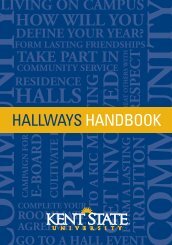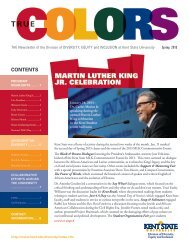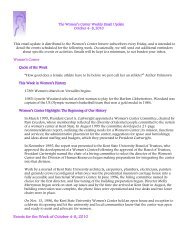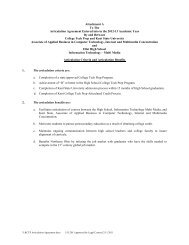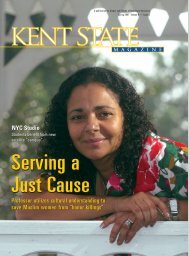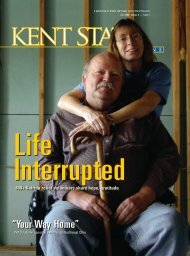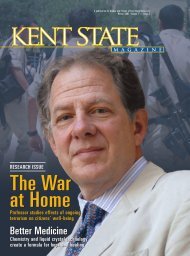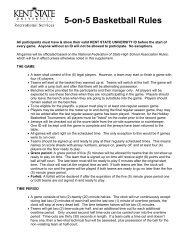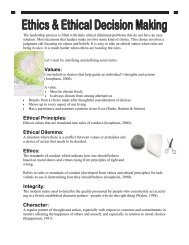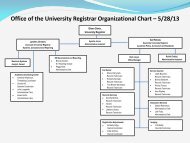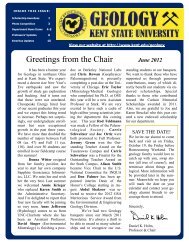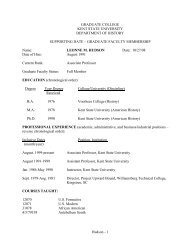Lester Lefton Lester Lefton - Kent State University
Lester Lefton Lester Lefton - Kent State University
Lester Lefton Lester Lefton - Kent State University
Create successful ePaper yourself
Turn your PDF publications into a flip-book with our unique Google optimized e-Paper software.
it (the planning) in a more<br />
concentrated area. We could<br />
then merge the UDC’s Oak<br />
Hill vision with our own<br />
2010 plan.”<br />
Oak Hill’s problems<br />
quickly became apparent<br />
to the <strong>Kent</strong> <strong>State</strong> students:<br />
Dispersed, open-land vacancies<br />
between homes that had<br />
no likely demand for development,<br />
with residents moving<br />
into homes only briefly<br />
and then leaving. The region<br />
also suffers from tax foreclosures<br />
and property abatements.<br />
In fact, some students<br />
found it difficult to comprehend<br />
why anyone would<br />
want to stay in the area, says<br />
Todd Hutchinson, ’83, B.S. in<br />
architecture ’05, M.arch. ’06,<br />
who was a graduate student<br />
in the urban design program<br />
at that time.<br />
“But the residents were<br />
definitely committed not<br />
only to staying, but also to<br />
working to solve the problems.<br />
They really felt that<br />
with a little help from the<br />
government, city and county,<br />
they could make it better,”<br />
Hutchinson says. “They were<br />
not looking for a handout,<br />
only to be realistic in terms<br />
of how much they wanted for<br />
the vacant land.”<br />
“Oak Hill was an ideal<br />
location for the shrinking<br />
cities charrette,” says Terry<br />
Schwarz, senior planner at<br />
the Urban Design Center.<br />
“We knew that we had to<br />
create new nodes of activity<br />
in the neighborhood.”<br />
Lana Mitchell-Wells participates<br />
in a group discussion at<br />
the Urban Design Center charrette<br />
held in her Youngstown<br />
neighborhood.<br />
With guidance from<br />
Urban Design Center faculty<br />
and staff, as well as College<br />
of Architecture faculty, the<br />
16 graduate students divided<br />
into four teams to meet<br />
with Oak Hill residents and<br />
develop designs that would<br />
make the most of the area’s<br />
existing conditions — from<br />
drainage and road conditions,<br />
to proximity to Mill Creek<br />
Park, natural topography and<br />
the stunning architecture of<br />
the older homes that offered<br />
wonderful views of downtown<br />
Youngstown — and, at<br />
the same time, convert it into<br />
region of greater sustainability.<br />
“The conversations<br />
ranged from innovative and<br />
ambitious ideas to very practical<br />
suggestions,” Schwarz<br />
says. “The residents presented<br />
a wealth of ideas, and<br />
their presence really helped.<br />
Having the community working<br />
directly with us made the<br />
process more fun; the experience<br />
was liberating for the<br />
students.”<br />
The community’s participation<br />
in the charettes<br />
gave the students valuable<br />
information about the history<br />
of the neighborhood, as<br />
well as a sense of its present<br />
problems and needs, says<br />
Marjiana Saljanoska, a second-year<br />
graduate student at<br />
the center.<br />
“Some of their suggestions<br />
for improving the quality<br />
of life in their community<br />
were really thoughtful and<br />
realistic, and many of them<br />
were taken into consideration<br />
during the design process,”<br />
she says.<br />
Community interaction<br />
helps the students gain “realworld<br />
grounding,” Schwarz<br />
explains. “In a classroom setting<br />
this would seem artificial,<br />
but in this case, students<br />
have to respond to issues that<br />
were out of their control,<br />
which helps them to create<br />
well-designed plans that also<br />
function well.”<br />
Hutchinson agrees that<br />
the experience allows students<br />
to understand better<br />
the actual communities in<br />
which they will be working at<br />
some point.<br />
“It’s one thing to design<br />
in the vacuum of an academic<br />
studio, but something far different<br />
in the real world,” he<br />
says. “This was an excellent<br />
way to compress an incredible<br />
amount of design and collaboration<br />
into an extremely<br />
short period of time.”<br />
After hours of lengthy<br />
discussions and planning, the<br />
students unveiled possible<br />
solutions and visions for the<br />
area. Ideas included demolishing<br />
deteriorated buildings<br />
and excess vegetation to<br />
make way for a community<br />
center, creating small parks<br />
for residents to enjoy the<br />
outdoors and installing wind<br />
turbines on select pieces of<br />
vacant property to help generate<br />
electricity and reduce<br />
energy costs for the residents.<br />
“The drawings the students<br />
presented were good<br />
looking and well thoughtout.<br />
The ideas were realistic,<br />
yet innovative,” Kobak says.<br />
“The visions excited the<br />
community and restored<br />
hope in the future. It helped<br />
them to understand that<br />
things can be better than<br />
they are now.”<br />
A new, lush landscape in<br />
a thriving urban neighborhood<br />
may not be so hard<br />
to imagine in Youngstown<br />
after all.<br />
For more information<br />
about the Urban Design<br />
Center and the charrette,<br />
visit www.kent.edu/<br />
magazine.<br />
Online Exclusive<br />
Lake County<br />
charrette<br />
reveals growth potential<br />
Following the successful<br />
Youngstown-area charrette,<br />
Urban Design Center students<br />
and faculty conducted a similar<br />
program in Lake County,<br />
Ohio. Read about it at<br />
www.kent.edu/magazine.<br />
p a g e1 5



